headlamp PONTIAC G8 2009 User Guide
[x] Cancel search | Manufacturer: PONTIAC, Model Year: 2009, Model line: G8, Model: PONTIAC G8 2009Pages: 356, PDF Size: 1.83 MB
Page 190 of 356
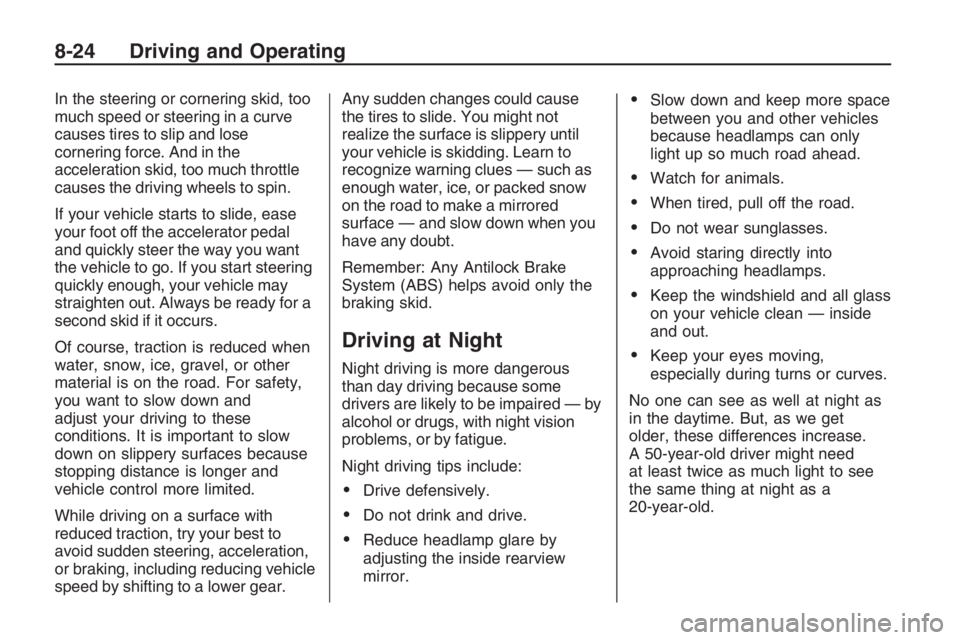
In the steering or cornering skid, too
much speed or steering in a curve
causes tires to slip and lose
cornering force. And in the
acceleration skid, too much throttle
causes the driving wheels to spin.
If your vehicle starts to slide, ease
your foot off the accelerator pedal
and quickly steer the way you want
the vehicle to go. If you start steering
quickly enough, your vehicle may
straighten out. Always be ready for a
second skid if it occurs.
Of course, traction is reduced when
water, snow, ice, gravel, or other
material is on the road. For safety,
you want to slow down and
adjust your driving to these
conditions. It is important to slow
down on slippery surfaces because
stopping distance is longer and
vehicle control more limited.
While driving on a surface with
reduced traction, try your best to
avoid sudden steering, acceleration,
or braking, including reducing vehicle
speed by shifting to a lower gear.Any sudden changes could cause
the tires to slide. You might not
realize the surface is slippery until
your vehicle is skidding. Learn to
recognize warning clues — such as
enough water, ice, or packed snow
on the road to make a mirrored
surface — and slow down when you
have any doubt.
Remember: Any Antilock Brake
System (ABS) helps avoid only the
braking skid.
Driving at Night
Night driving is more dangerous
than day driving because some
drivers are likely to be impaired — by
alcohol or drugs, with night vision
problems, or by fatigue.
Night driving tips include:
Drive defensively.
Do not drink and drive.
Reduce headlamp glare by
adjusting the inside rearview
mirror.
Slow down and keep more space
between you and other vehicles
because headlamps can only
light up so much road ahead.
Watch for animals.
When tired, pull off the road.
Do not wear sunglasses.
Avoid staring directly into
approaching headlamps.
Keep the windshield and all glass
on your vehicle clean — inside
and out.
Keep your eyes moving,
especially during turns or curves.
No one can see as well at night as
in the daytime. But, as we get
older, these differences increase.
A 50-year-old driver might need
at least twice as much light to see
the same thing at night as a
20-year-old.
8-24 Driving and Operating
Page 195 of 356
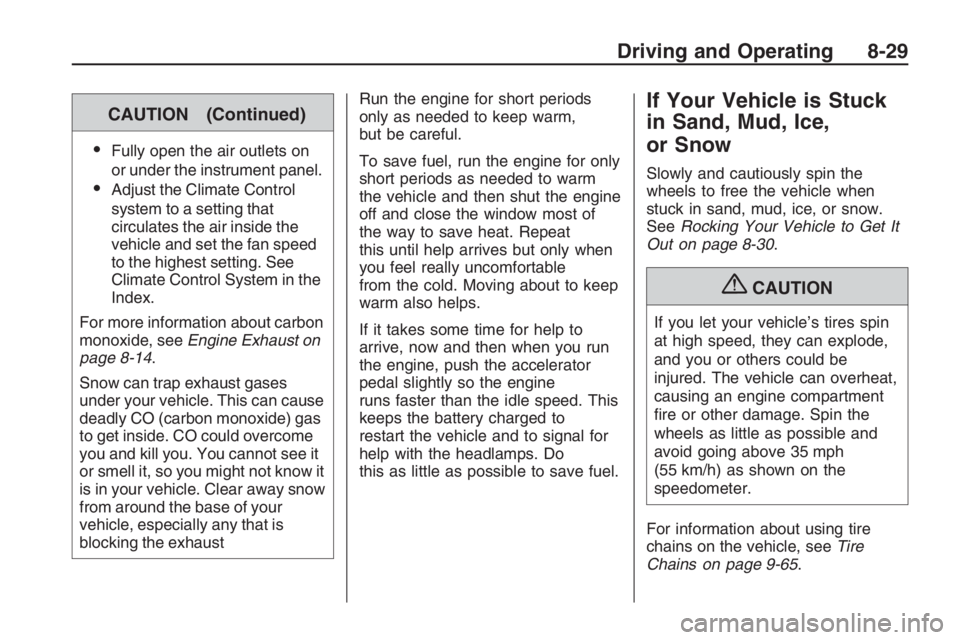
CAUTION (Continued)
Fully open the air outlets on
or under the instrument panel.
Adjust the Climate Control
system to a setting that
circulates the air inside the
vehicle and set the fan speed
to the highest setting. See
Climate Control System in the
Index.
For more information about carbon
monoxide, seeEngine Exhaust on
page 8-14.
Snow can trap exhaust gases
under your vehicle. This can cause
deadly CO (carbon monoxide) gas
to get inside. CO could overcome
you and kill you. You cannot see it
or smell it, so you might not know it
is in your vehicle. Clear away snow
from around the base of your
vehicle, especially any that is
blocking the exhaustRun the engine for short periods
only as needed to keep warm,
but be careful.
To save fuel, run the engine for only
short periods as needed to warm
the vehicle and then shut the engine
off and close the window most of
the way to save heat. Repeat
this until help arrives but only when
you feel really uncomfortable
from the cold. Moving about to keep
warm also helps.
If it takes some time for help to
arrive, now and then when you run
the engine, push the accelerator
pedal slightly so the engine
runs faster than the idle speed. This
keeps the battery charged to
restart the vehicle and to signal for
help with the headlamps. Do
this as little as possible to save fuel.
If Your Vehicle is Stuck
in Sand, Mud, Ice,
or Snow
Slowly and cautiously spin the
wheels to free the vehicle when
stuck in sand, mud, ice, or snow.
SeeRocking Your Vehicle to Get It
Out on page 8-30.
{CAUTION
If you let your vehicle’s tires spin
at high speed, they can explode,
and you or others could be
injured. The vehicle can overheat,
causing an engine compartment
�re or other damage. Spin the
wheels as little as possible and
avoid going above 35 mph
(55 km/h) as shown on the
speedometer.
For information about using tire
chains on the vehicle, seeTire
Chains on page 9-65.
Driving and Operating 8-29
Page 205 of 356
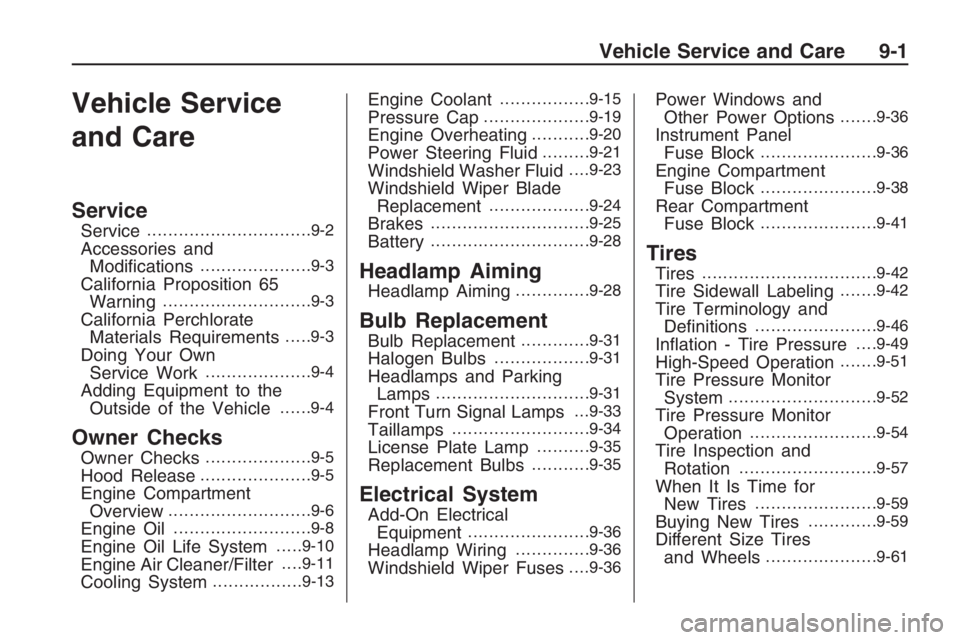
Vehicle Service
and Care
Service
Service...............................9-2
Accessories and
Modi�cations.....................9-3
California Proposition 65
Warning............................9-3
California Perchlorate
Materials Requirements.....9-3
Doing Your Own
Service Work....................9-4
Adding Equipment to the
Outside of the Vehicle......9-4
Owner Checks
Owner Checks....................9-5
Hood Release.....................9-5
Engine Compartment
Overview...........................9-6
Engine Oil..........................9-8
Engine Oil Life System.....9-10
Engine Air Cleaner/Filter. . . .9-11
Cooling System.................9-13
Engine Coolant.................9-15
Pressure Cap....................9-19
Engine Overheating...........9-20
Power Steering Fluid.........9-21
Windshield Washer Fluid. . . .9-23
Windshield Wiper Blade
Replacement...................9-24
Brakes..............................9-25
Battery..............................9-28
Headlamp Aiming
Headlamp Aiming..............9-28
Bulb Replacement
Bulb Replacement.............9-31
Halogen Bulbs..................9-31
Headlamps and Parking
Lamps.............................9-31
Front Turn Signal Lamps. . .9-33
Taillamps..........................9-34
License Plate Lamp..........9-35
Replacement Bulbs...........9-35
Electrical System
Add-On Electrical
Equipment.......................9-36
Headlamp Wiring..............9-36
Windshield Wiper Fuses. . . .9-36
Power Windows and
Other Power Options.......9-36
Instrument Panel
Fuse Block......................9-36
Engine Compartment
Fuse Block......................9-38
Rear Compartment
Fuse Block......................9-41
Tires
Tires.................................9-42
Tire Sidewall Labeling.......9-42
Tire Terminology and
De�nitions.......................9-46
In�ation - Tire Pressure. . . .9-49
High-Speed Operation.......9-51
Tire Pressure Monitor
System............................9-52
Tire Pressure Monitor
Operation........................9-54
Tire Inspection and
Rotation..........................9-57
When It Is Time for
New Tires.......................9-59
Buying New Tires.............9-59
Different Size Tires
and Wheels.....................9-61
Vehicle Service and Care 9-1
Page 232 of 356

Battery
This vehicle has a maintenance free
battery. When it is time for a new
battery, see your dealer/retailer
for one that has the replacement
number shown on the original
battery’s label. The battery is located
in the trunk behind a trim panel
on the driver’s side.
Warning:Battery posts, terminals,
and related accessories contain
lead and lead compounds,
chemicals known to the State of
California to cause cancer and
reproductive harm. Wash hands
after handling.
Vehicle Storage
{CAUTION
Batteries have acid that can burn
you and gas that can explode.
You can be badly hurt if you are
not careful. SeeJump Starting on
page 9-84for tips on working
around a battery without
getting hurt.
Infrequent Usage: If the vehicle is
driven infrequently, remove the
black, negative (−) cable from the
battery. This helps keep the battery
from running down.
Extended Storage: For extended
storage of the vehicle, remove
the black, negative (−) cable from
the battery or use a battery
trickle charger. This helps maintain
the charge of the battery over
an extended period of time.
Headlamp Aiming
The optical headlamp aiming system
has been preset at the factory
and should need no further
adjustment
However, if the vehicle is damaged
adjustment may be necessary.
If oncoming vehicles �ash their
high beams at you, this may also
mean the vertical aim needs to
be adjusted.
It is recommended that the vehicle
is taken to your dealer/retailer
for service if the headlamps need to
be re-aimed. It is possible however,
to re-aim the headlamps as
described.
9-28 Vehicle Service and Care
Page 233 of 356
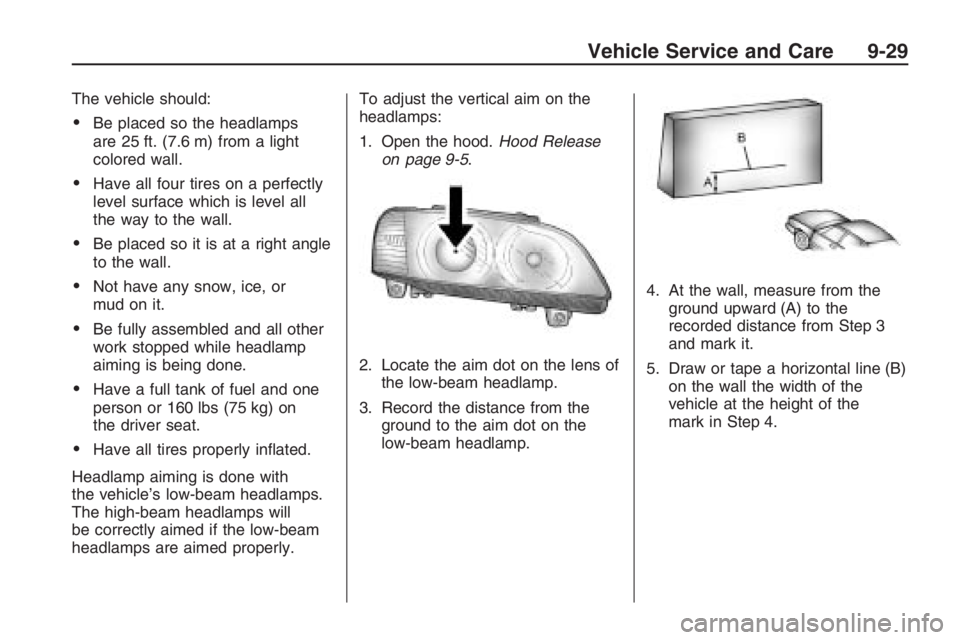
The vehicle should:
Be placed so the headlamps
are 25 ft. (7.6 m) from a light
colored wall.
Have all four tires on a perfectly
level surface which is level all
the way to the wall.
Be placed so it is at a right angle
to the wall.
Not have any snow, ice, or
mudonit.
Be fully assembled and all other
work stopped while headlamp
aiming is being done.
Have a full tank of fuel and one
person or 160 lbs (75 kg) on
the driver seat.
Have all tires properly in�ated.
Headlamp aiming is done with
the vehicle’s low-beam headlamps.
The high-beam headlamps will
be correctly aimed if the low-beam
headlamps are aimed properly.To adjust the vertical aim on the
headlamps:
1. Open the hood.Hood Release
on page 9-5.
2. Locate the aim dot on the lens of
the low-beam headlamp.
3. Record the distance from the
ground to the aim dot on the
low-beam headlamp.4. At the wall, measure from the
ground upward (A) to the
recorded distance from Step 3
and mark it.
5. Draw or tape a horizontal line (B)
on the wall the width of the
vehicle at the height of the
mark in Step 4.
Vehicle Service and Care 9-29
Page 234 of 356
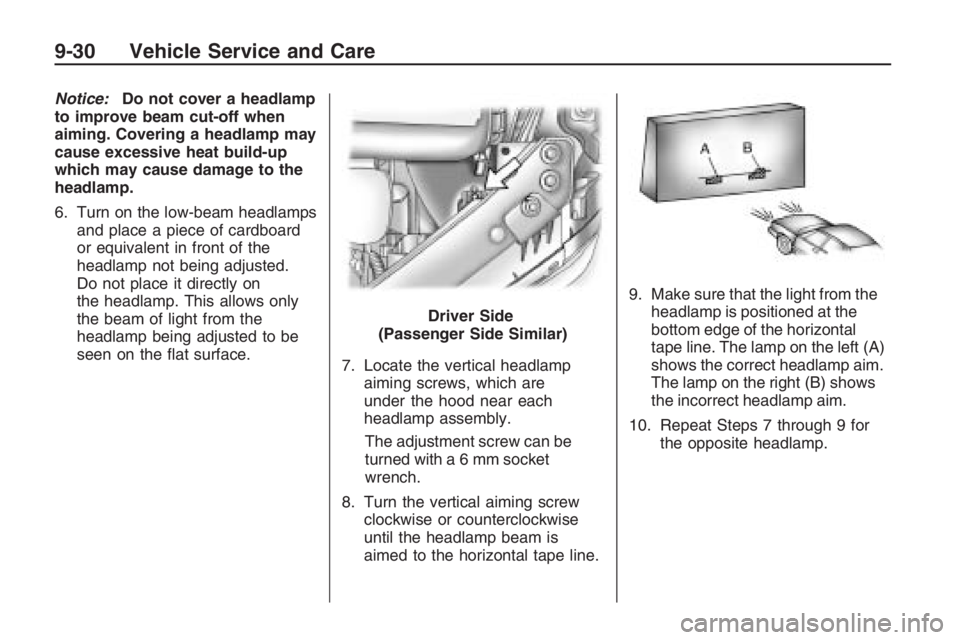
Notice:Do not cover a headlamp
to improve beam cut-off when
aiming. Covering a headlamp may
cause excessive heat build-up
which may cause damage to the
headlamp.
6. Turn on the low-beam headlamps
and place a piece of cardboard
or equivalent in front of the
headlamp not being adjusted.
Do not place it directly on
the headlamp. This allows only
the beam of light from the
headlamp being adjusted to be
seen on the �at surface.
7. Locate the vertical headlamp
aiming screws, which are
under the hood near each
headlamp assembly.
The adjustment screw can be
turned with a 6 mm socket
wrench.
8. Turn the vertical aiming screw
clockwise or counterclockwise
until the headlamp beam is
aimed to the horizontal tape line.9. Make sure that the light from the
headlamp is positioned at the
bottom edge of the horizontal
tape line. The lamp on the left (A)
shows the correct headlamp aim.
The lamp on the right (B) shows
the incorrect headlamp aim.
10. Repeat Steps 7 through 9 for
the opposite headlamp. Driver Side
(Passenger Side Similar)
9-30 Vehicle Service and Care
Page 235 of 356
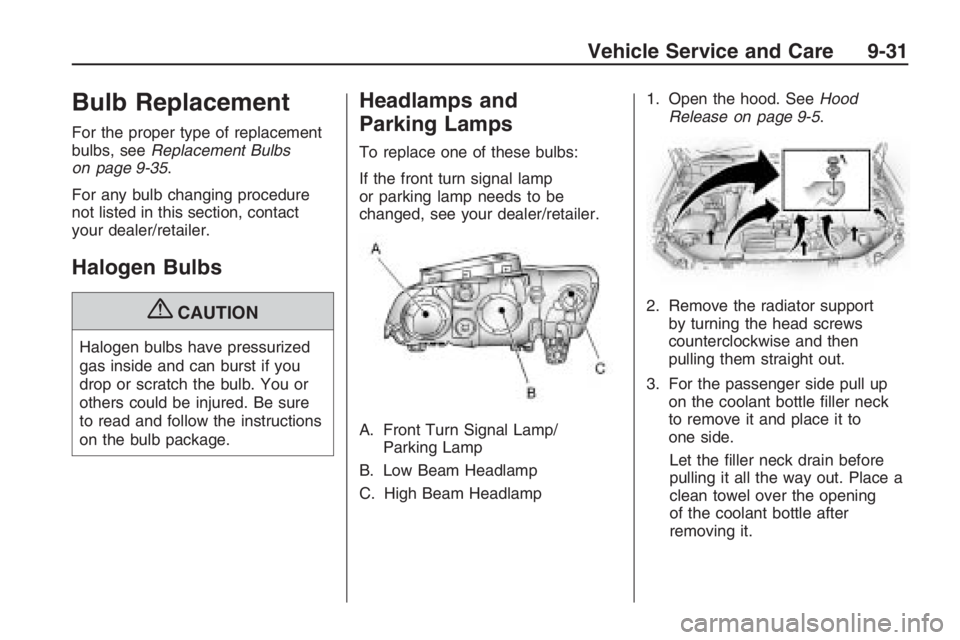
Bulb Replacement
For the proper type of replacement
bulbs, seeReplacement Bulbs
on page 9-35.
For any bulb changing procedure
not listed in this section, contact
your dealer/retailer.
Halogen Bulbs
{CAUTION
Halogen bulbs have pressurized
gas inside and can burst if you
drop or scratch the bulb. You or
others could be injured. Be sure
to read and follow the instructions
on the bulb package.
Headlamps and
Parking Lamps
To replace one of these bulbs:
If the front turn signal lamp
or parking lamp needs to be
changed, see your dealer/retailer.
A. Front Turn Signal Lamp/
Parking Lamp
B. Low Beam Headlamp
C. High Beam Headlamp1. Open the hood. SeeHood
Release on page 9-5.
2. Remove the radiator support
by turning the head screws
counterclockwise and then
pulling them straight out.
3. For the passenger side pull up
on the coolant bottle �ller neck
to remove it and place it to
one side.
Let the �ller neck drain before
pulling it all the way out. Place a
clean towel over the opening
of the coolant bottle after
removing it.
Vehicle Service and Care 9-31
Page 239 of 356
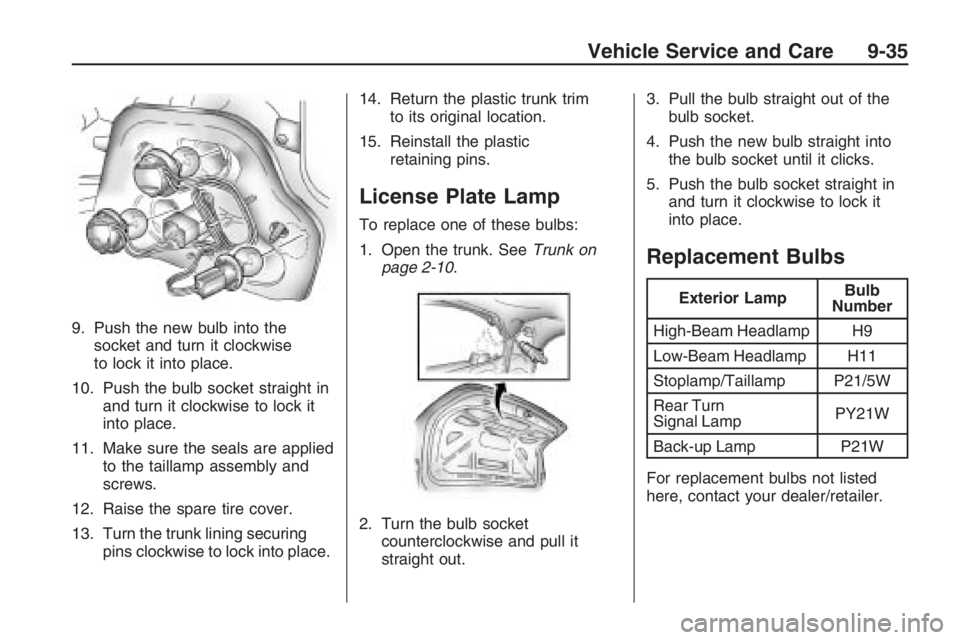
9. Push the new bulb into the
socket and turn it clockwise
to lock it into place.
10. Push the bulb socket straight in
and turn it clockwise to lock it
into place.
11. Make sure the seals are applied
to the taillamp assembly and
screws.
12. Raise the spare tire cover.
13. Turn the trunk lining securing
pins clockwise to lock into place.14. Return the plastic trunk trim
to its original location.
15. Reinstall the plastic
retaining pins.
License Plate Lamp
To replace one of these bulbs:
1. Open the trunk. SeeTrunk on
page 2-10.
2. Turn the bulb socket
counterclockwise and pull it
straight out.3. Pull the bulb straight out of the
bulb socket.
4. Push the new bulb straight into
the bulb socket until it clicks.
5. Push the bulb socket straight in
and turn it clockwise to lock it
into place.
Replacement Bulbs
Exterior LampBulb
Number
High-Beam Headlamp H9
Low-Beam Headlamp H11
Stoplamp/Taillamp P21/5W
Rear Turn
Signal LampPY21W
Back-up Lamp P21W
For replacement bulbs not listed
here, contact your dealer/retailer.
Vehicle Service and Care 9-35
Page 240 of 356
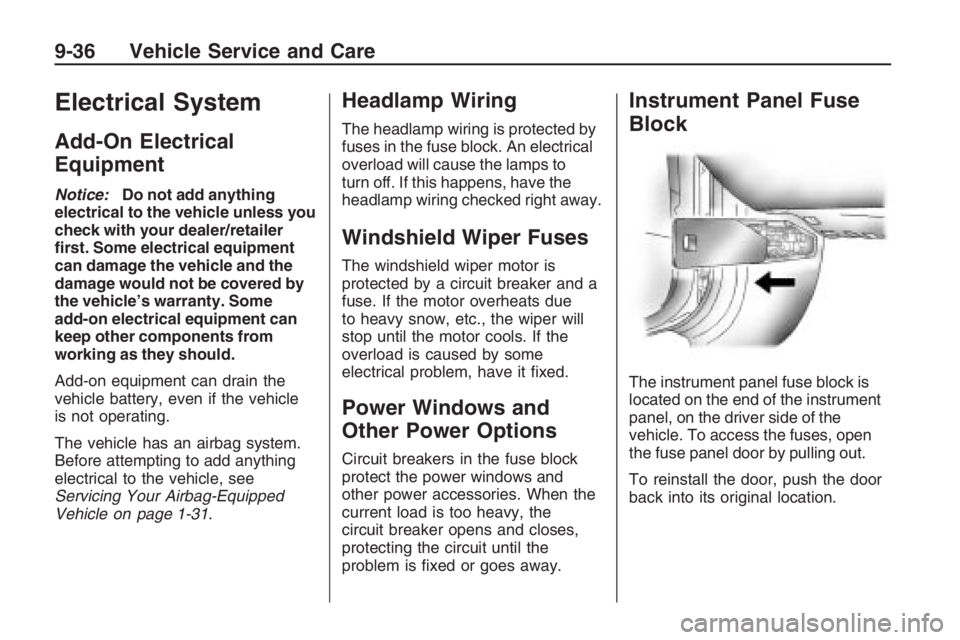
Electrical System
Add-On Electrical
Equipment
Notice:Do not add anything
electrical to the vehicle unless you
check with your dealer/retailer
�rst. Some electrical equipment
can damage the vehicle and the
damage would not be covered by
the vehicle’s warranty. Some
add-on electrical equipment can
keep other components from
working as they should.
Add-on equipment can drain the
vehicle battery, even if the vehicle
is not operating.
The vehicle has an airbag system.
Before attempting to add anything
electrical to the vehicle, see
Servicing Your Airbag-Equipped
Vehicle on page 1-31.
Headlamp Wiring
The headlamp wiring is protected by
fuses in the fuse block. An electrical
overload will cause the lamps to
turn off. If this happens, have the
headlamp wiring checked right away.
Windshield Wiper Fuses
The windshield wiper motor is
protected by a circuit breaker and a
fuse. If the motor overheats due
to heavy snow, etc., the wiper will
stop until the motor cools. If the
overload is caused by some
electrical problem, have it �xed.
Power Windows and
Other Power Options
Circuit breakers in the fuse block
protect the power windows and
other power accessories. When the
current load is too heavy, the
circuit breaker opens and closes,
protecting the circuit until the
problem is �xed or goes away.
Instrument Panel Fuse
Block
The instrument panel fuse block is
located on the end of the instrument
panel, on the driver side of the
vehicle. To access the fuses, open
the fuse panel door by pulling out.
To reinstall the door, push the door
back into its original location.
9-36 Vehicle Service and Care
Page 244 of 356
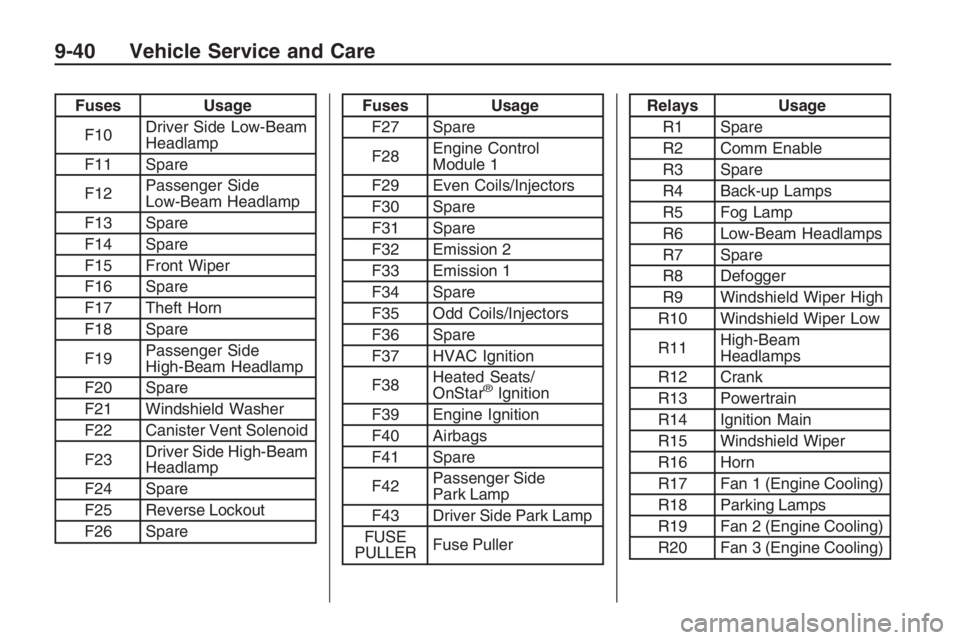
Fuses Usage
F10Driver Side Low-Beam
Headlamp
F11 Spare
F12Passenger Side
Low-Beam Headlamp
F13 Spare
F14 Spare
F15 Front Wiper
F16 Spare
F17 Theft Horn
F18 Spare
F19Passenger Side
High-Beam Headlamp
F20 Spare
F21 Windshield Washer
F22 Canister Vent Solenoid
F23Driver Side High-Beam
Headlamp
F24 Spare
F25 Reverse Lockout
F26 SpareFuses Usage
F27 Spare
F28Engine Control
Module 1
F29 Even Coils/Injectors
F30 Spare
F31 Spare
F32 Emission 2
F33 Emission 1
F34 Spare
F35 Odd Coils/Injectors
F36 Spare
F37 HVAC Ignition
F38Heated Seats/
OnStar
®Ignition
F39 Engine Ignition
F40 Airbags
F41 Spare
F42Passenger Side
Park Lamp
F43 Driver Side Park Lamp
FUSE
PULLERFuse Puller
Relays Usage
R1 Spare
R2 Comm Enable
R3 Spare
R4 Back-up Lamps
R5 Fog Lamp
R6 Low-Beam Headlamps
R7 Spare
R8 Defogger
R9 Windshield Wiper High
R10 Windshield Wiper Low
R11High-Beam
Headlamps
R12 Crank
R13 Powertrain
R14 Ignition Main
R15 Windshield Wiper
R16 Horn
R17 Fan 1 (Engine Cooling)
R18 Parking Lamps
R19 Fan 2 (Engine Cooling)
R20 Fan 3 (Engine Cooling)
9-40 Vehicle Service and Care